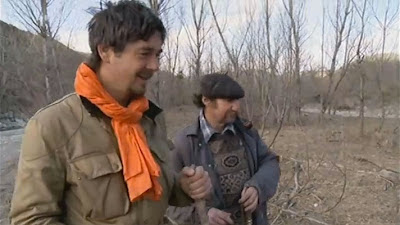Episode #5 of the road movie was presented yesterday afternoon.
Still in the Cévennes,
François met up with a friendly pipe-smoking shepherd.
The traditional grazing method involves seasonal operations known as
transhumance. The shepherd walks his flocks up to highlands for the summer season, then back down to the plains for winter.
During the brief sequence, no less than three new lambs were born, with no problems.
François and the shepherd looked on, amused (there was no cause for alarm), as one of the ewes continued to follow the flock with the head of her half-born lamb sticking out behind her.
A few minute later on, the baby was sitting on the ground.
The shepherd collected the lambs by their front legs and carried them over to where the main flock was located.
Next, François met up with a man who organizes walking excursions in the company of Provençal donkeys.
The conversation moved inevitably to the story of the writer Robert Louis Stevenson [1850-1894], author of Travels with a Donkey in the Cévennes. As a Scottish Presbyterian, Stevenson had been fascinated by tales of the Protestant insurgents in the Cévennes, back in the time of Louis XIV, who became known as Camisards. At that time (1879), Stevenson was troubled by his romantic attachment to a married woman, Fanny Osbourne, ten years his senior and the mother of three children, who had abandoned him temporarily. (A year later, she would later become his wife.)
What better way to meditate about religious history and romance than while walking across the Cévenol mountains in the company of a faithful donkey...
François then followed an itinerant butcher on an excursion to isolated villages and houses.
In this sparsely-populated corner of France,
Didier's meat van has remained a vital service.
François then met up with a rural puppeteer.
Here we see the most famous puppet of all time:
Polichinelle, from the Italian
Commedia dell'arte.
The puppets' heads have been created by talented sculptors.
Then the puppeteer paints them and dresses them up.
In former times, puppeteers would operate at rural fairs, in order to attract customers to the merchants' stands.
François was thrilled to discover that he had his own puppet.
They all set off on the orange moped—François, his puppet and the puppeteer—to reach the place where the puppeteer's mobile theater was parked.
François and Polichinelle were the stars of the show...
At the end of the day, François stopped for a moment in the village of Ganges to pay homage to
Charles Benoit, inventor of the moped. He left an orange scarf attached to the commemorative plaque.
Finally, the episode terminated with a short trip in a hot-air balloon: an 18th-century French invention of the brothers
Joseph-Michel and
Jacques-Étienne Montgolfier.
The orange moped surely enjoyed the excursion into the skies of the Cévennes.
François certainly did.























ليست هناك تعليقات:
إرسال تعليق